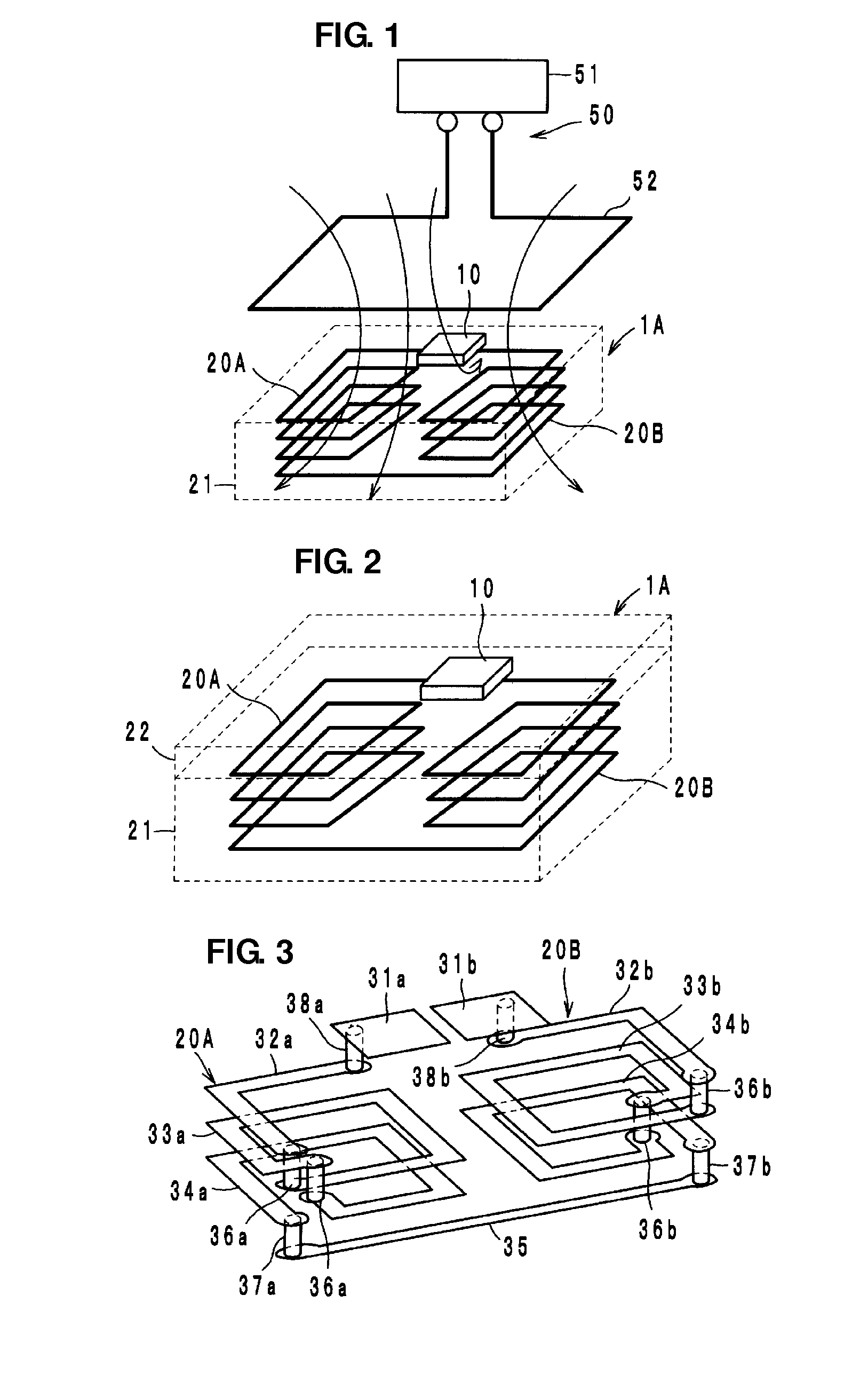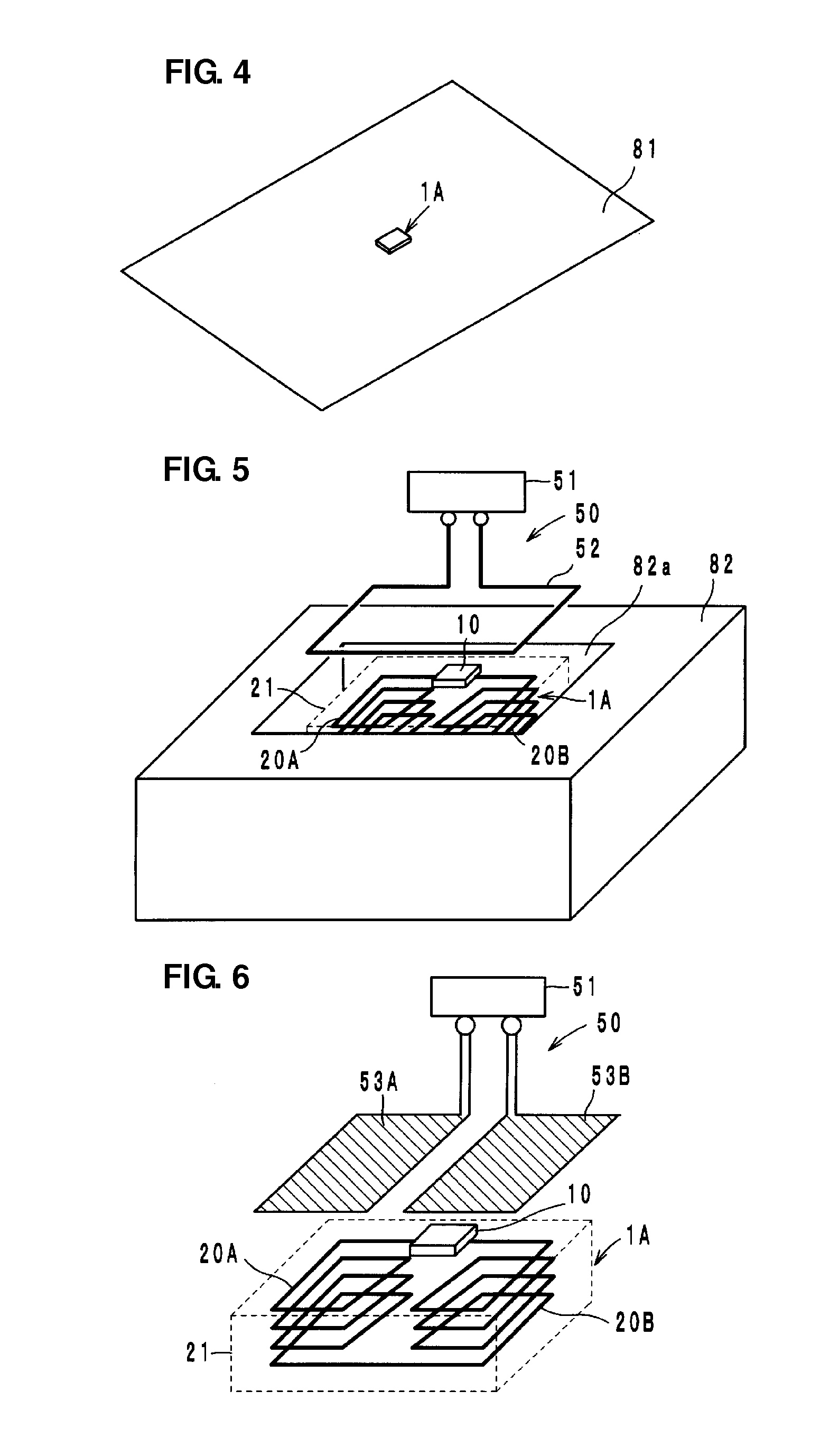Wireless IC tag, reader-writer, and information processing system
a technology of integrated circuits and tags, applied in the field of wireless integrated circuit tags, can solve the problems of reducing the communication distance, and reducing the energy transfer efficiency between the wireless ic tag and the reader-writer, so as to increase the communication distance, and improve the energy transfer efficiency
- Summary
- Abstract
- Description
- Claims
- Application Information
AI Technical Summary
Benefits of technology
Problems solved by technology
Method used
Image
Examples
first preferred embodiment
[0036]A wireless IC tag 1A according to a first preferred embodiment of the present invention preferably includes a wireless IC chip 10 that processes transmission and reception signals having certain frequencies and two coil-shaped antennas 20A and 20B, as shown in FIG. 1.
[0037]The wireless IC chip 10 preferably includes a clock circuit, a logic circuit, a memory circuit, and other suitable circuit elements and necessary information is stored in the wireless IC chip 10. A pair of input-output terminal electrodes (not shown) is provided on the rear surface of the wireless IC chip 10.
[0038]Each of the coil-shaped antennas 20A and 20B preferably includes conductors that are wound in a coil shape. One end of the coil-shaped antenna 20A and one end of the coil-shaped antenna 20B are electrically connected to the input-output terminal electrodes on the wireless IC chip 10. The other end of the coil-shaped antenna 20A is electrically connected to the other end of the coil-shaped antenna 2...
second preferred embodiment
[0061]A wireless IC tag 1B according to a second preferred embodiment of the present invention preferably includes outer electrodes 23A and 23B provided on a surface (bottom surface) of the substrate 21 including the antennas 20A and 20B so as to oppose the antennas 20A and 20B, respectively, as shown in FIG. 12. The remaining configuration of the wireless IC tag 1B is preferably the same or substantially the same as that of the wireless IC tag 1A. The outer electrodes 23A and 23B enable the wireless IC tag 1B to be soldered to an article, such as a printed wiring board, for example.
[0062]Bringing a probe (not shown) into contact with the outer electrodes 23A and 23B or positioning the probe close to the outer electrodes 23A and 23B enables the wireless IC tag 1B to operate. The probe preferably has an impedance that is a conjugate of the impedance between the outer electrodes 23A and 23B. As described above, a difference in voltage occurs between the antennas 20A and 20B and a diff...
third preferred embodiment
[0065]In a wireless IC tag 1C according to a third preferred embodiment of the present invention, the outer electrodes 23A and 23B provided on the wireless IC tag 1B are preferably electrically connected to the coil-shaped antennas 20A and 20B, respectively, as shown in FIG. 14. An equivalent circuit of the wireless IC tag 1C is shown in FIG. 15. Alternatively, a capacitance C1 may be provided between the outer electrode 23A and the coil-shaped antenna 20A and a capacitance C2 may be provided between the outer electrode 23B and the coil-shaped antenna 20B (refer to FIG. 16).
[0066]Directly electrically connecting the outer electrodes 23A and 23B to the coil-shaped antennas 20A and 20B, respectively, as shown in FIG. 14, enables the relationship in voltage between the outer electrodes 23A and 23B and the coil-shaped antennas 20A and 20B to be easily determined, thus easily setting the impedance of the outer electrodes 23A and 23B to various values. Connecting the outer electrodes 23A ...
PUM
 Login to View More
Login to View More Abstract
Description
Claims
Application Information
 Login to View More
Login to View More - R&D
- Intellectual Property
- Life Sciences
- Materials
- Tech Scout
- Unparalleled Data Quality
- Higher Quality Content
- 60% Fewer Hallucinations
Browse by: Latest US Patents, China's latest patents, Technical Efficacy Thesaurus, Application Domain, Technology Topic, Popular Technical Reports.
© 2025 PatSnap. All rights reserved.Legal|Privacy policy|Modern Slavery Act Transparency Statement|Sitemap|About US| Contact US: help@patsnap.com



